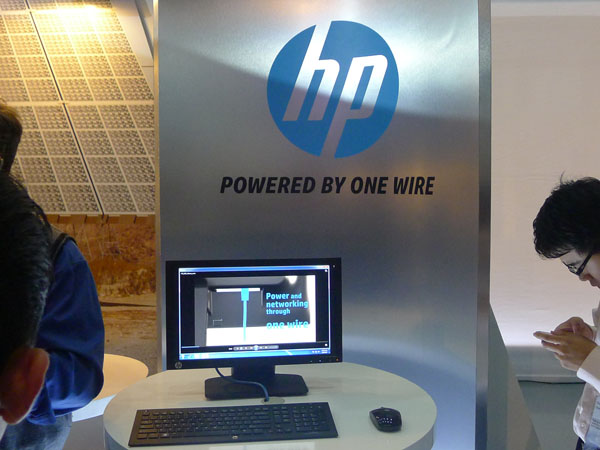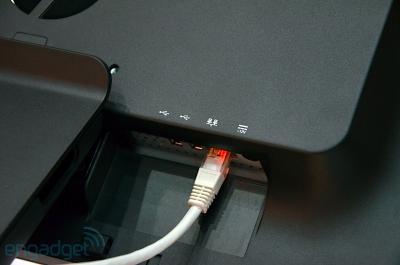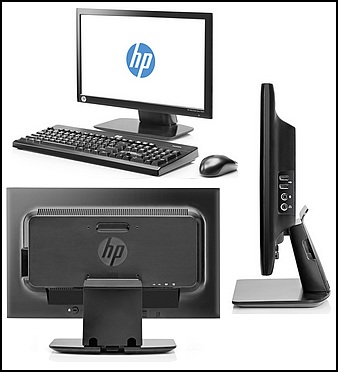Overview
One and Only
HP’s lowest-power all-in-one smart zero client, delivering PC-like performance using a single wire for power and network connectivity. Simplify your desktop with zero management and zero compromise.
Features
All-in-One design
• Create a powerful, client virtualization environment with a streamlined all-in-one solution that combines thin client security and management for impressive PC-like performance.
• The innovative design features an 18.5” diagonal LED monitor for a small desktop footprint.
Power-over-Ethernet
• Experience our lowest powered, all-in-one smart zero client with Type 1 Power-over-Ethernet – designed to operate within a 13-watt power envelope at 200 nits of brightness through Power-over-Ethernet.
• Benefit from a faster, one-wire set-up. Just plug in your Power-over-Ethernet wire and you’re ready. No A/C attach required.
PC-like Performance
• Built using a high performance Texas Instruments TMS320DM8148 ARM® Cortex processor with 1 GB DDR3 SDRAM and 2GB eMMC Flash memory capacity.
• Supports Microsoft®, Citrix and VMware (including PCoIP) VDI implementations in a single “appliance” set-up.
• Featuring DSP Acceleration for RemoteFX, PCoIP and ARM® Neon extensions for Citrix SoC for a more flexible user experience.
HP Smart Zero Client Technology
• Reduce poor network connectivity in densely populated work environments with HP Velocity, a new HP feature. As network conditions change, HP Velocity reacts to maintain the highest quality performance.
• Simplify your IT atmosphere with complete configuration and reconfiguration control over your operating system.
• Automatic Intelligence, inherited by HP Smart Zero Client Services, establishes a secure desktop environment for all devices in minutes, and downloads everything it needs to deliver a robust user experience.
• If your client virtualization software changes your HP Smart Client will adapt to your environment. Simply repurpose your HP Smart Client for another protocol, saving time and money.
Eco-highlights
• Help reduce your company’s operating costs with HP’s first, ultra-low power, Type 1 PoE – Power-over-Ethernet – all-in-one smart zero client solution.
• The HP t410 All-in-One Smart Zero Client also leads the industry in the development of environmental thin client technologies:
ENERGY STAR® qualified
EPEAT ® Gold registered
Low halogen materials
Backed by HP
• HP Thin Clients are backed by HP global service and support through our network of over 50,000 IT professionals in over 100 countries.
• The HP t410 All-in-One Smart Zero Client includes a standard, three-year limited hardware warranty in most regions.
• Choose from HP Care Pack Services to extend service contracts beyond your standard warranties. For more details visit http://www.hp.com/go/lookuptool.
Review
By Joel Snyder | Network World US
Thin clients can’t be cracked or hacked; they don’t have fans or disks to fail; they don’t need to be patched nearly as often as Windows; they don’t draw much power; and they don’t cost a whole lot of money to buy or maintain.
Enterprises choosing the desktop virtualisation path with Microsoft Terminal Services, Citrix XenApp, or VMware View use thin clients instead of desktop PCs to connect end users to applications.
HP has an extensive thin client business, competing with a handful of vendors, especially Dell Wyse, and both companies offer a variety of headless (monitorless) devices with various speeds and configurations.
And normally they’re not all that exciting. But the HP t410 All-in-One is different.
HP’s t410 All-in-One client, which started shipping late in 2012, takes the thin client concept to a bare minimum: nothing but a monitor with a few USB ports for keyboard and mouse, using standard Power over Ethernet just 13 watts, compatible with any old IEEE 802.3af switches. You don’t even have to upgrade your PoE switches to support high-power 802.3at.
Testing the HP t410 All-in-One
We took the t410 for an extended spin in our lab, powering the device with an off-the-shelf Enterasys 48-port switch. Because the t410 uses PoE, networking is limited to 100Mbps Ethernet speeds. The t410 also supports an external power supply, which most users won’t want unless you plan to attach extra USB devices that draw more than 100 mA of current. In that case, PoE won’t provide enough power and you’ll have to switch to a local power supply.
We tested the Windows Remote Desktop Protocol (RDP) to talk to Windows 2003 and Windows 2008 Terminal Servers, and the Citrix ICA protocol to talk to a Citrix XenApp 6.5 server farm. Some models also support VMware View, which we did not test.
Windows RDP worked perfectly right out of the box, and we started off with an unfair test: video. While the t410 All-in-One does support audio, and it makes a valiant try with video, you’re not going to be using this for watching cat videos or cheese-making tutorials.
Of course, the problem isn’t with the t410 itself, but with the RDP protocol, but we wanted to see for ourselves. For low-rate video, the t410 actually does a surprisingly good job and we got even better results when we switched from Windows RDP to Citrix ICA protocol because the t410 supports Citrix’ HDX high definition video capabilities.
The HP t410 All-in-One has a wide-format 18-inch diagonal screen with 1366 x 768 pixels. That’s plenty for most business applications, but a little pixel-shy compared to today’s 21 inch and larger monitors. If your terminal services application requires more pixels or a larger screen, the All-in-One is not for you.
We tried a number of applications, including Oracle eBusiness ERP, Salesforce.com CRM, the OCLC library catalog, as well as general web browsing. In every application, the smaller size screen was functional, but by no means luxurious. A few extra pixels would have been nice.
Overall, the HP t410 All-in-One behaved exactly as we expected. Although the CPU inside (a 1 GHz ARM) is slow by modern desktop standards, it had plenty of oomph to drive the video and the protocols needed for snappy desktop behavior.
HP offers Velocity, a QoS technology that is used to improve performance of thin clients over poor quality links, such as remote offices or noisy Wi-Fi. Windows servers (and Hyper-V virtualisation hosts) with Velocity installed will negotiate with the HP thin client and send self-correcting network traffic when link quality is impaired. We had no problem getting Velocity installed on a Windows 2008 server, and once we had calmed down our IPS about the unexpected options inserted into the IP packets traffic, we could tell that it was working.
However, we really weren’t able to perceive any differences in performance between Velocity enabled and Velocity disabled when we inserted our Shunra link emulator and began to introduce errors into the connection between the t410 All-in-One and our Windows server. It could be that we just didn’t hit the right set of parameters and traffic that would really exercise Velocity, but it didn’t turn out to be a big distinguishing factor for us.
Managing the HP t410 All-in-One
Most enterprises deploying thin clients will deploy a lot of them, and simplified management is important. HP has these bases covered quite well with a combination of device features and free management applications.
The t410 All-in-One will operate perfectly well without any management tools, and this is how we started our testing. The device boots up, gets an IP address (or has a static one configured) and then is ready for use. We attached a keyboard and mouse and then used the on-screen menus to select a protocol (Windows RDP or Citrix ICA, in our case) and identify the host we wanted to connect. The t410 prompted us for username, password, and domain (or to log in with a Smart Card, a feature we were unable to test) and we were off testing the product.
To integrate the t410 All-in-One into a management framework requires a little network infrastructure change to let the thin client know which management server to use, and the installation of HP’s Smart Client Services management tool on a Windows server.
To get the t410 All-in-One to find its Smart Client server, we had the option of sending a special DHCP option down or adding a well-known DNS name of “auto-update;” we picked the latter as it was the easiest for us. The DHCP tag approach might be more useful to enterprises with multiple Smart Client Services systems, so that different subnets would use different servers.
We used the Smart Client Services application to define a profile for our t410 All-in-One, including settings such as network parameters, time settings, screen layout and localisation instructions. In less than two hours, we had installed the tools and fully customised our t410 All-in-One.
A second tool, the HP Device Manager, is used for device inventory and software updates. Unfortunately, HP hasn’t combined these two tools into a single package, which was a disappointment. The two tools overlap very slightly, but once we had installed both of them, we were often confused as to which tool to use for what, and which tool we should select for a particular task. HP undoubtedly has historic reasons for having two tools instead of one, but customers would probably be happier with a single tool that does it all.
Even with two tools, the overall management of the thin clients was simple, especially compared to the alternative of managing individual PCs. Even when we added local devices such as printers and scanners to the t410 All-in-One, the customisations were quick and obvious. There’s no question that the total cost of ownership of thin clients such as the t410 All-in-One kicks traditional desktop computing off the table without much of a fight.



